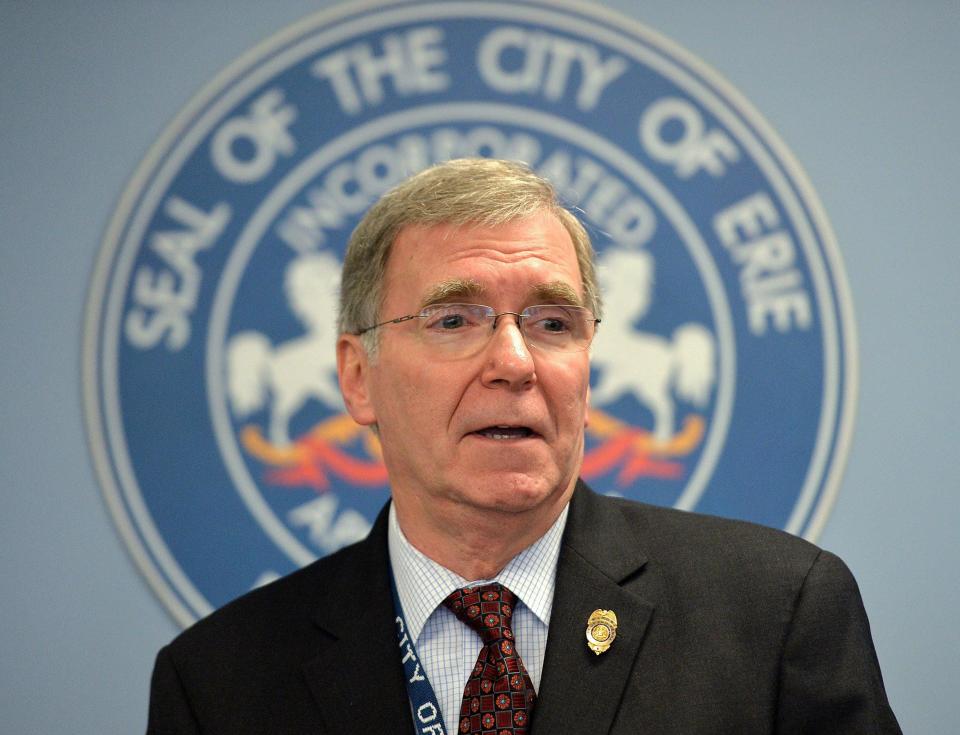Erie police seek $14.5M in COVID funds to add 21 officers, curb juvenile crime, aid crisis calls
Erie police have taken a number of steps in recent years to quell a rise in violent crime, particularly among juveniles.
The police have an active role in Unified Erie, an anti-crime initiative launched 11 years ago to battle gun violence and to guide people away from trouble.
They are involved in various task forces, including the FBI-led Erie Area Gang Law Enforcement Safe Streets Task Force and the Erie Law Enforcement Crime Task Force Gun Working Group, which aim to curb gun violence and to get guns off the street.
And they have launched programs including the Erie Police Athletic League and the Community Outreach Program to build stronger relationships between police and the city's youth.

Police Chief Dan Spizarny has another idea, pulled from his department's history, that he believes will also go a long way in keeping Erie's young from becoming involved in violent crime: the reinstatement of the police's Juvenile Crime Unit.
Bringing back that unit — which Spizarny said went away in 2005, when city budget issues led to the elimination of the jobs of 40 officers — is one of the highlights of a proposal by police and Erie Mayor Joe Schember's administration for nearly $14.5 million in funding from the city's $76 million American Rescue Plan allocation.
The proposal, which Spizarny outlined to members of Erie City Council during a work session on Nov. 18 and during a news conference on Tuesday afternoon, also calls for reinstating the bureau's "Crisis Car," to handle crisis calls related to mental health, homeless and domestic incidents; adding officers to the police bureau's Neighborhood Action Team and the Police Athletic League and Community Outreach Program; and providing equipment and vehicles to those officers.
The proposal, if approved, would add 21 officers to the 175-member Erie Bureau of Police and the funding would pay for them for five years, according to Spizarny.
He said efforts would be made to explore other funding avenues to keep those officers working beyond the five years, noting the bureau's previous success in finding funding sources for some of its existing officers.
Nine current members of the bureau are paid for by outside sources. Six are officers in the bureau's Quebec Unit, which covers Erie Housing Authority property and whose salaries are reimbursed by the authority through a federal grant; two are the bureau's insurance fraud and auto theft investigators, who are paid for through state grants; and one is the bureau's full-time Police Athletic League coordinator and recruitment coordinator, a position also funded by a grant.
"It would be the first increase in 15 years," Spizarny said of the proposed staff increase. "I think the citizens of Erie would like to feel safer. I think the officers would like to know there's more help around."
Schember wants Erie City Council to approve the funding at the panel's next regular meeting on Wednesday. He said the plan would help make Erie “a safer community for everyone.”

Schember also called the proposed hiring of new officers “one of the most important and most transformative actions we can take with ARP funds. We have worked on this with our community partners. … They all agree with this approach."
Schember said that if City Council signs off on the proposal, the new police officers could be hired as soon as May.
City Councilwoman Kathy Schaaf supports the plan.

“We need more officers in the streets and neighborhoods. I am a big supporter of this,” Schaaf said. "We need more officers working side by side on mental health situations. I could go on and on. People have called and emailed (about the need to see officers in their neighborhoods."
Councilman Michael Keys, however, said he has concerns about how the new officers would be funded long-term, after ARP funding is exhausted.

"I would not support the plan as it is presented right now," Keys said.
City Council approved the use of $31 million in ARP funds at its Nov. 17 meeting. That funding focuses on reducing blight, housing rehabilitation, assisting businesses, funding environmental cleanups and a host of other initiatives
More: Housing help, business grants and more: Erie City Council OKs $31M deployment of COVID funds
Juvenile crime
Spizarny's proposal seeks $4 million to add six detectives whose primary function would be to investigate crimes involving juveniles and work with Erie School District police and Erie County Juvenile Probation.
He said he believes the 15 years the bureau has functioned without juvenile detectives has been a "major factor" in the uptick in shootings and gang activity in the city.
The number of homicides in Erie over a five-year period has grown steadily from 20 between 2001 and 2005 to 48 between 2016 and 2020. Of the 44 homicides between 2011 and 2015, two victims were 16 years old and two suspects were 14 years old, Spizarny said. Of the homicides between 2016 and 2020, one victim was 14 and two suspects were 14, he said.

Spizarny said that, through mid-November, Erie police had 500 more documented contacts with juveniles at calls or during investigations than they had five years ago. The number of juvenile arrests was nearly 300 five years ago, and so far this year there have been less than 150, he said.
Erie leaders address violent crime spike: Erie leaders address basketball court shooting, spike in violent crime
The juvenile detectives would be dedicated to investigating all crimes involving juveniles and to hold those juveniles accountable in an effort to prevent them from committing larger crimes later, Spizarny said. He said there are now no detectives following up on minor juvenile crimes, and that the only time cases involving juveniles are assigned is if it is a major crime.
"It's not that we are looking to arrest more juveniles. But we want them to be held accountable to prevent them from becoming involved in more violent crime," Spizarny said.
In addition to working juvenile cases, the new detectives would assist the bureau's current detectives in investigating unassigned criminal cases, Spizarny said. He said the bureau's 21 detectives in 2020 handled more than 3,000 Part 1 crimes, which include homicides, robberies, aggravated assaults and sex offenses; and nearly 5,000 Part 2 crimes, which include simple assaults, frauds and weapons violations. The FBI uses the Part 1 and Part 2 classifications.
"We're talking 8,000 cases with 21 detectives assigned. It's a tremendous workload," Spizarny said.
Because of that, a number of cases don't get assigned, Spizarny said. There were 1,425 unassigned cases in 2020, and so far this year 1,615 cases have not been assigned, he said.
Crisis services
The largest ARP allocation requested in Spizarny's proposal, $6 million, would be used to hire nine officers to reinstate a Crisis Unit. That unit, which formerly paired a mental health worker and a police officer, shut down a number of years ago.
Spizarny said a two-officer "Crisis Car" would work all three police shifts, seven days a week. The officers would work with social service and mental health workers to respond to calls involving mental health issues and would work with SafeNet on domestic dispute calls.
The officers would additionally work with Erie's homeless population and would deal with issues in the city's downtown, he said.
Mandy Fauble, executive director of Safe Harbor Behavioral Health of UPMC Hamot, applauded the city’s ARP proposal.

Fauble said crisis response approaches that reinforce de-escalation are often safer and more effective for law enforcement when dealing with domestic violence situations, people who suffer from mental illness or those who struggle with drug or alcohol addiction.
Pandemic's impact: COVID-19 takes toll on mental health, services demand in Erie County
Fauble also said law enforcement responses that focus on crisis management can also “help divert people from the criminal justice system," because treatment is a better option than arrest/incarceration in many cases.
“I’m very pleased to support this effort,” Fauble said.
DA Domestic Violence Unit aids victims: DA Jack Daneri's new Domestic Violence Unit gives victims another way to call for help
Spizarny said the police bureau has seen a significant increase in the number of "assist other agency" calls, from 2,404 in 2017 to nearly 3,000 this year. He said there are "a number of variables" in those calls, but "the one big thing is mental health calls."
The Crisis Car, when it was established in Erie decades ago, was one of the first in the country utilized by a police department, Spizarny said. It was also very successful in providing aid to those in need, he said.
"The agencies knew the car, they knew the benefit of it," he said.
Community outreach
Spizarny's proposal additionally seeks $4 million to add four officers to the bureau's Neighborhood Action Team — which has four officers but has lost five since 2015, Spizarny said — and two officers to the Police Athletic League and Community Outreach Program.
The Neighborhood Action Team, which police said works high-crime hours between 8 p.m. and 4 a.m., focuses on drug activity and gang and gun violence. Its members also attend neighborhood watch meetings and work to build relationships with residents of those neighborhoods, Spizarny said.
The two officers sought for the Police Athletic League and Community Outreach Program would provide those programs with full-time officers to do community outreach, recruitment and trust-building initiatives, Spizarny said. It would also free up the supervisors of those programs, Sgt. Tom Lenox and Cpl. Jamie Russo, to devote their efforts to building and expanding those programs, he said.
Erie police lauded for outreach efforts: Acting U.S. attorney recognizes efforts to strengthen police-community relationships in Erie
The Police Athletic League, under the direction of Lenox, has grown from an after-school program in a few Erie elementary schools to programs in all elementary and middle schools and some local centers. The program, which involves hundreds of Erie children and dozens of police officers, also runs summer programs including a weeklong summer camp.
Spizarny said the grant that is paying for Lenox's position as league coordinator and recruitment officer expires in mid-2022, and without another funding source Lenox would have to go back to his regular patrol duties.
"The P.A.L. program has been doing wonderful things," Spizarny said. "These kids are hitting high school age, and we want to make sure we are growing and staying on track."
The Community Outreach Program runs an after-school and summer program at the Booker T. Washington Center, works with the Erie School District to help teach the high school protective services program and has representatives attend neighborhood watch meetings and programs.
Spizarny said in his pitch for ARP funding that 140 of the city's police officers fill 200 roles in working on the various crime-fighting task forces and on community outreach efforts such as the Police Athletic League in addition to their regular duties. The additional officers would help with that workload, he said.
Spizarny also said that the bureau has cut costs, through $6 million in payroll savings in decreased pay increases in an eight-year contract with the city's police union and by extending the pay increment for new officers from three years to five years; and through $4.5 million in grants and initiatives received since 2018.
"So we're doing everything we can," he said.
Contact Tim Hahn at thahn@timesnews.com. Follow him on Twitter @ETNhahn.
Contact Kevin Flowers at kflowers@timesnews.com. Follow him on Twitter at @ETNflowers.
This article originally appeared on Erie Times-News: Erie crime: Police seek COVID funding cut to add cops, restart units

